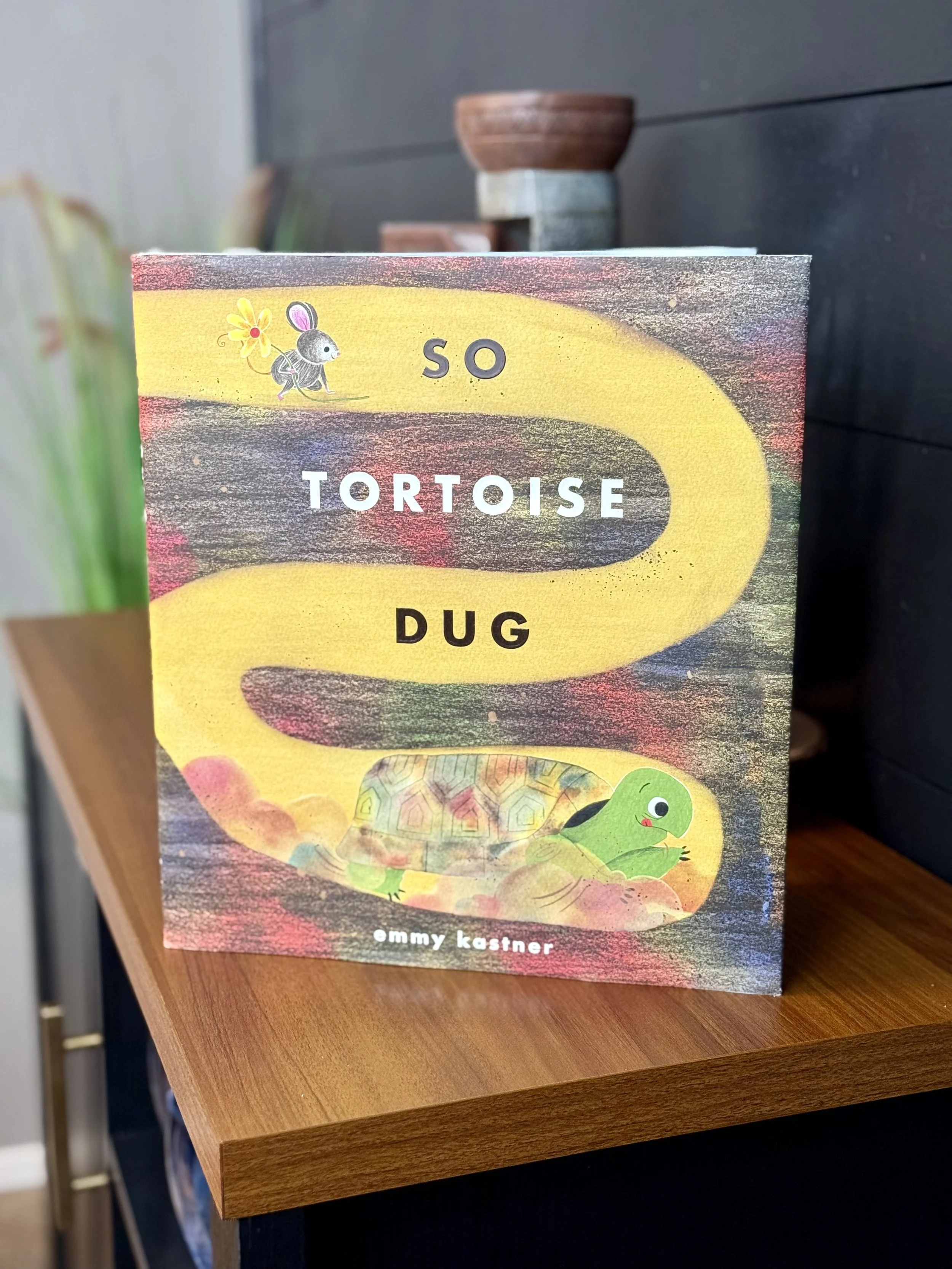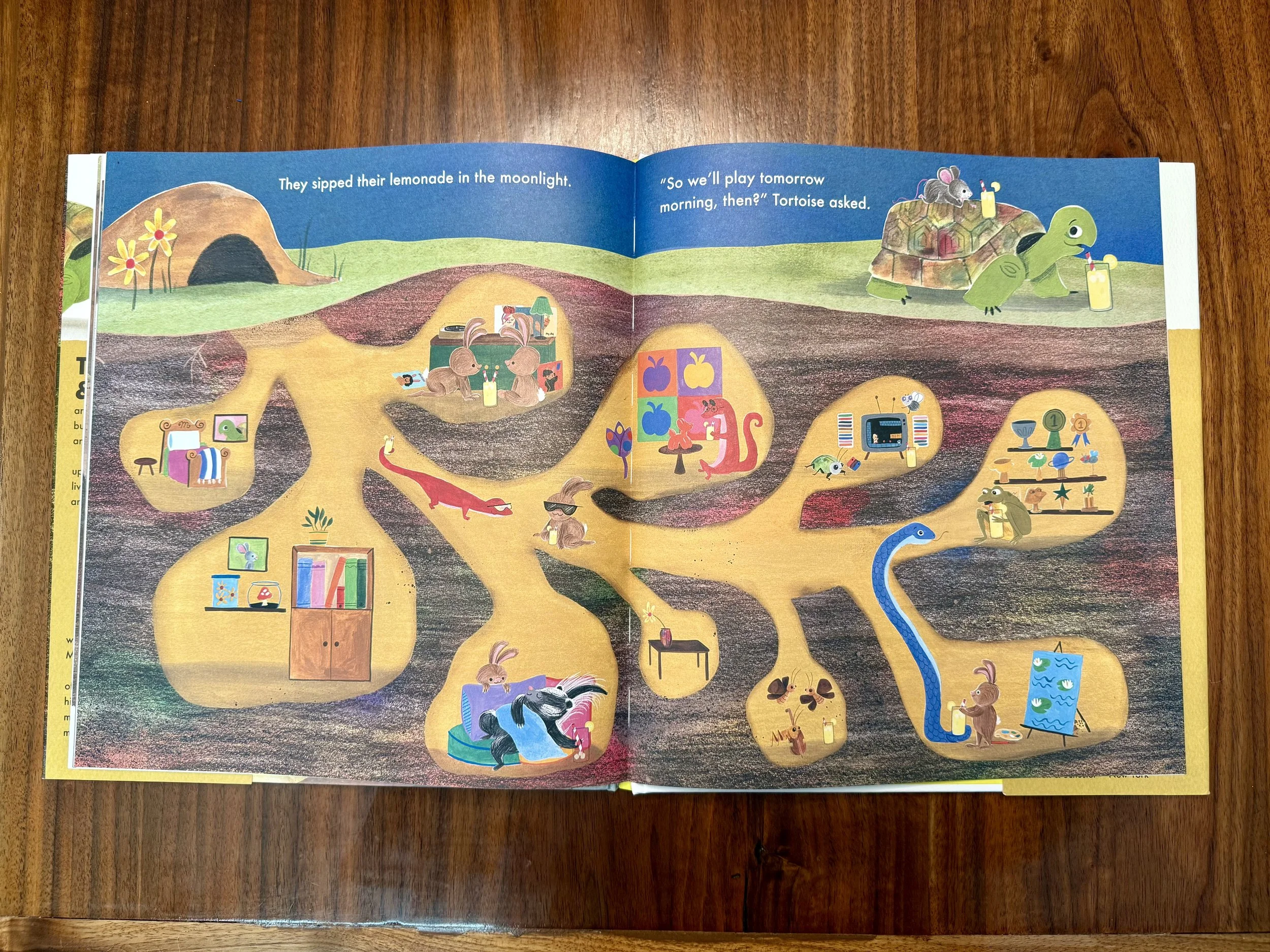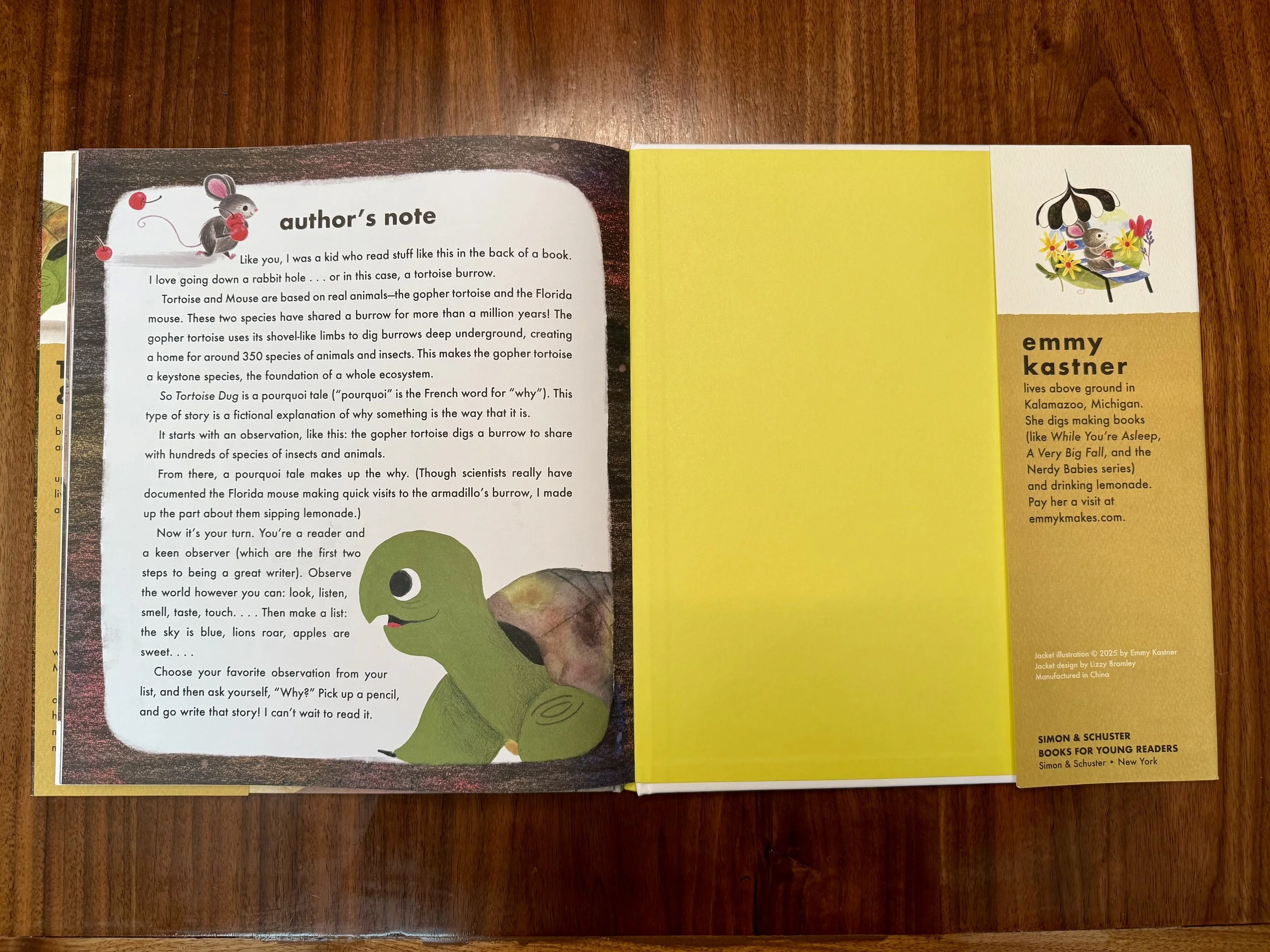So Tortoise Dug: Journaling About Curiosity, Patience, and Discovery
Disclosure: Writing Mindset only endorses things that I’ve personally used, something similar, or come highly recommended by trusted peers. If you grab anything I mention using a referral link, I may get a small commission. However, there’s no extra cost to you. If you would like to learn more, please visit the privacy policy and disclosure page.
Emmy Kastner’s So Tortoise Dug is a gentle, inspiring story about a tortoise who does what tortoises do best—dig! But as Tortoise digs, she discovers more than dirt and tunnels. She uncovers wonder, quiet courage, and the joy of moving at her own pace. Through Kastner’s warm language and playful illustrations, readers are invited to celebrate curiosity, self-trust, and the slow beauty of discovery. I also really love the nonfiction connections here as we encourage (as both teachers and parents) kids to be aware of the world around them. The book is based off of the real relationship of how two species coexist in the wild: the gopher tortoise and the Florida mouse. In the Author’s Note, Emmy goes on to explain that the book is a “pourquoi tale (“pourquoi” is the french word for “why”) This type of story is a fictional explanation of why something is the way that it is.” I love the idea of writers being able to explain real-world concepts through made up stories.
For writers and journalers alike, So Tortoise Dug reminds us that every creative journey takes time. It encourages us to keep going, keep digging, and find joy in uncovering what’s beneath the surface of our thoughts, stories, and dreams.
In this post, you can find…
Tips for using this book as a mentor text for writing
Ways to use the book with preschoolers, grades k-5, grades 6-8, grades 9-12, and for disciplinary literacy projects
Journaling prompts linked to the book (including nature journaling)
One grammar exercise to access grammar instruction
Using So Tortoise Dug as a Mentor Text
This mentor text was selected for its clear narrative structure and use of suspense, showing young writers how to build tension and resolution in a story. The playful tone and engaging plot make it appealing for emergent readers, while also modeling effective pacing, sentence variety, and character development that can inspire students in their own creative storytelling.
When reading Kastner’s book, notice how she:
Centers curiosity as action – Digging becomes a metaphor for learning, growing, and exploring.
Uses repetition and rhythm – The phrasing moves like the tortoise herself: steady, grounded, intentional.
Invites patience – Discovery takes time, and Tortoise shows that progress happens slowly, layer by layer.
Connects emotion to motion – Each movement downward leads to a deeper understanding of the self.
As a mentor text, So Tortoise Dug invites us to think about what we’re “digging into” in our own lives—our work, creativity, learning, or identity—and what treasures we might find when we keep going.
Journaling Prompt: “What Am I Digging Into?”
Open your journal and reflect on the idea of digging as a metaphor for learning or growing. Try one of these prompts:
“I am digging into…” (a habit, a project, a dream, a part of myself)
“When I keep going, even when it’s hard, I discover…”
“What lies beneath the surface of what I’m working on?”
“My curiosity leads me toward…”
Use sensory details or metaphors inspired by the earth—soil, roots, tunnels, stones—to describe your process of discovery.
Example:
I dig into questions and find roots of old stories. I dig into silence and find a voice I’d forgotten was mine.
Why This Works
Metaphors about the earth—digging, planting, growing—are timeless symbols of reflection and renewal. Journaling through these images helps us slow down, notice patterns, and find meaning in the work of becoming. So Tortoise Dug reminds us that progress doesn’t have to be fast to be meaningful; growth often happens just beneath the surface.
👉 Try it today: Write for ten minutes using the phrase “I dig because…” and see what emerges.
In my notebook, I wanted to share a page of curiosity about turtles and tortoises. In our local area, out nature preserve has Western Painted Turtles, so I completed a page after taking some pictures of them in the outdoors. Connecting story, grammar, and journaling in a way that fosters learning would be a great introductory activity to learning in the outdoors, but also coupling fiction (Kastner’s book) with nonfiction topics (learning about turtles and tortoises).
For Educators: Bringing So Tortoise Dug into the Classroom
Preschool Literacy Connections
Young readers are natural explorers, making this story perfect for early literacy.
After reading, ask: What does Tortoise find when she digs? What might you find if you dug like Tortoise?
Invite children to draw what’s “under the ground” in their imaginations—worms, treasure, roots, or magic tunnels.
Build vocabulary with sensory words: dirt, dark, cool, deep, slow.
Connect to real-world experiences: sandboxes, gardens, or nature walks.
Grades K–5
Elementary students can use this story to connect curiosity, perseverance, and observation.
Write short poems or journal entries starting with “So I dug…”
Discuss how curiosity leads to discovery in both learning and life.
Create a class project where students draw cross-sections of what they imagine “below” everyday objects—a tree, a sidewalk, or even a thought bubble.
Link to science lessons on habitats, soil layers, or underground ecosystems.
Grades 6–8
Middle schoolers can take the theme of digging deeper into self-discovery and growth.
Begin with a quick-write: “Something I’m trying to understand more deeply is…”
Use metaphor to explore internal landscapes—what’s hidden beneath the surface of a feeling, memory, or idea?
Discuss perseverance and curiosity as essential habits for learners and writers.
Pair with journal reflection on effort and progress: How do I keep digging when things feel challenging?
Grades 9–12
Older students can use So Tortoise Dug to reflect on process, persistence, and creative identity.
Connect the book’s themes to the writing process: drafting, revising, and returning to an idea until it takes shape.
Use the text as a metaphor for research or discovery in science and history: What do we uncover when we keep asking questions?
Invite students to write creative essays or poems about something they’ve “dug into”—a cause, topic, or belief.
Explore the power of pace—how slowing down can lead to deeper insight.
Disciplinary Literacy Connections
So Tortoise Dug can be used across content areas to inspire thinking and creativity:
Science: Explore soil composition, animal burrows, or fossil formation; write from the perspective of something underground.
Social Studies: Discuss the idea of “unearthing history”—what stories or artifacts tell us about the past?
Art: Create layered artwork showing what lies above and below the surface.
Math: Connect digging to measurement—depth, distance, and estimation—then write a reflection: How do we measure progress when it’s not visible?
Across disciplines, So Tortoise Dug reminds students that discovery takes time and curiosity is a lifelong tool for learning.
Grammar Focus: Sentence-Level Craft
Skill Focus: Using so as a conjunction or add-on
Kastner’s book is filled with gentle action, and so becomes a natural bridge that shows cause and effect without interrupting the rhythm of the sentence. Writers can use so to signal what happens because of an action, or to extend the moment with a soft, reflective turn. In student writing, so can be a powerful way to connect ideas, build momentum, or show reaction.
Model how adding so can deepen the meaning, first with compounds sentences:
Tortoise dug all morning, so she was relieved when the cool air finally reached her shell.
The earth was quiet and steady, so I trusted myself to follow its rhythm.
The tunnel twisted to the left, so Tortoise adjusted her path and kept digging.
I paused at the edge of the garden, so my breathing could match the calm around me.
If you are looking to take this work to the next level, you can also teach students how to use participial phrases with the compound sentence. Like this:
Digging through the dark soil, Tortoise wanted her friends to have a home, so she kept going even when the tunnel grew narrow.
Listening to the quiet earth, I found the rhythm of my own thoughts, so I slowed down and stayed with the moment a little longer.
Invite students to experiment by writing one sentence of gentle action and then extending it with so to show what happens next. This small shift teaches them how conjunctions can guide pacing, reveal thinking, and create a more fluid reading experience.
>> Want to Learn More about Grammar and Mentor Texts? Read “Using Mentor Texts to Teach Compound Sentences”
Nature Journaling Connection
Take So Tortoise Dug outside! Encourage observation of the ground, soil, and what lies unseen.
Have students record what they notice when they sit quietly in nature—sounds, textures, movements.
Sketch or describe underground life: roots, bugs, pebbles, tunnels.
Use metaphor to connect nature to mindset: My roots grow where I give attention.
Additional Journal Prompts for Wellness
Use the idea of digging to reflect on emotional or personal growth:
“What part of my life needs patience right now?”
“What am I learning about myself as I dig deeper into my routines or goals?”
“What layers of thought or feeling am I uncovering this season?”
“What helps me keep going when I feel stuck?”
These prompts emphasize curiosity as a form of care—reminding us that inner work, like Tortoise’s digging, is steady and full of purpose.
Final Thought:
So Tortoise Dug celebrates the beauty of slow discovery. It’s a story—and a reminder—that curiosity, patience, and persistence are the true paths to growth. Whether journaling, creating, or learning, we all have something worth digging into. The treasure is in the process.






